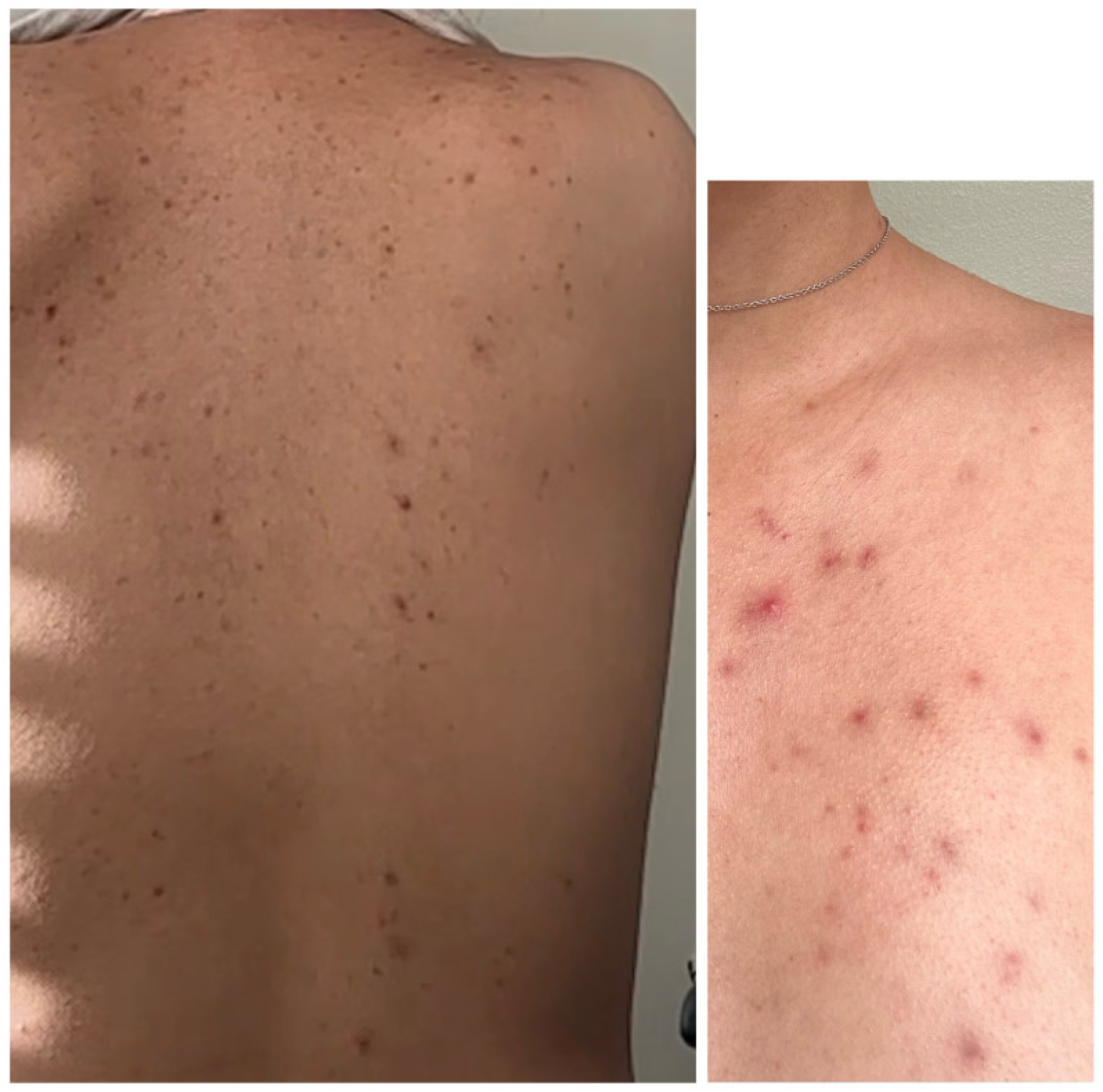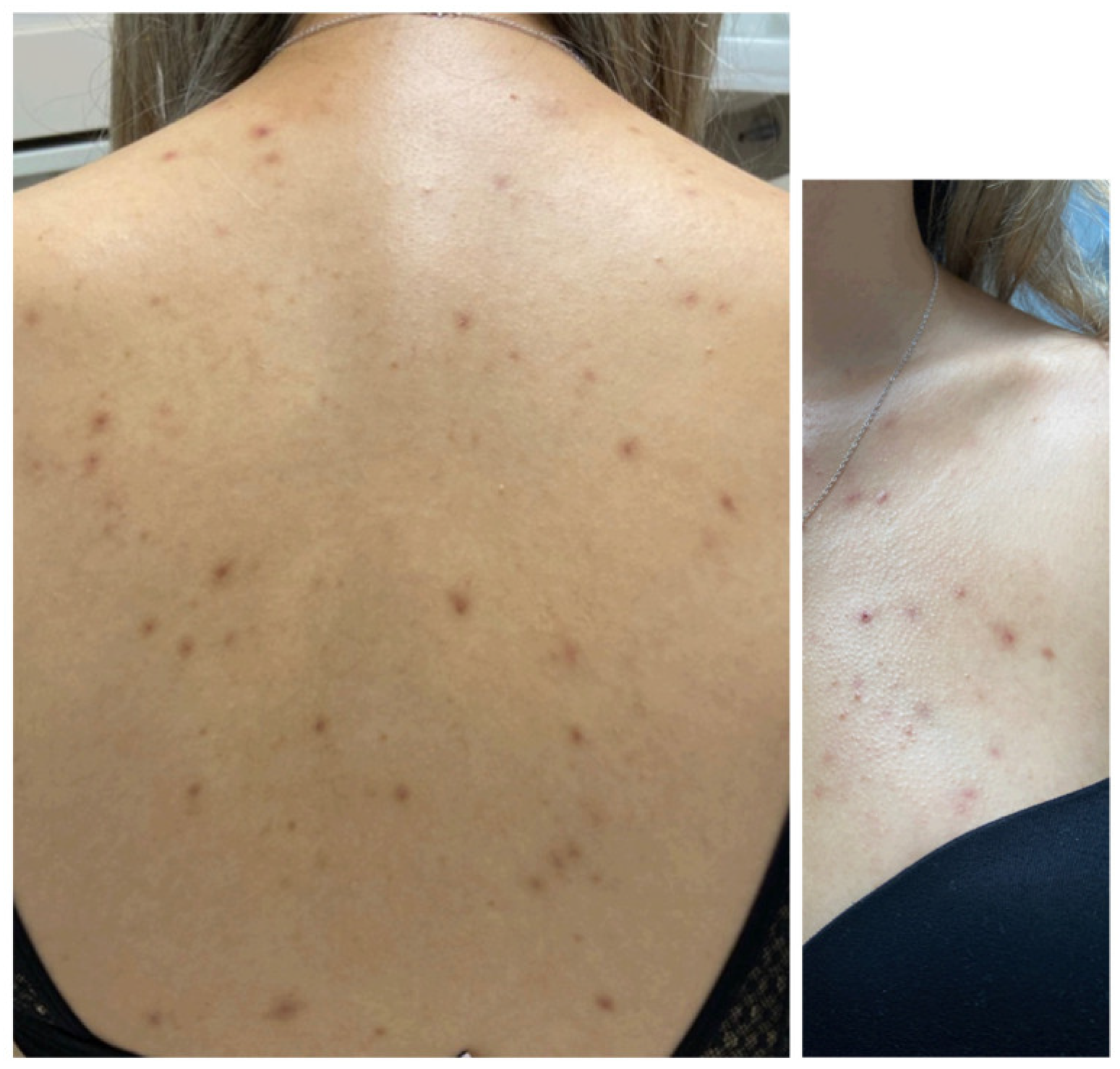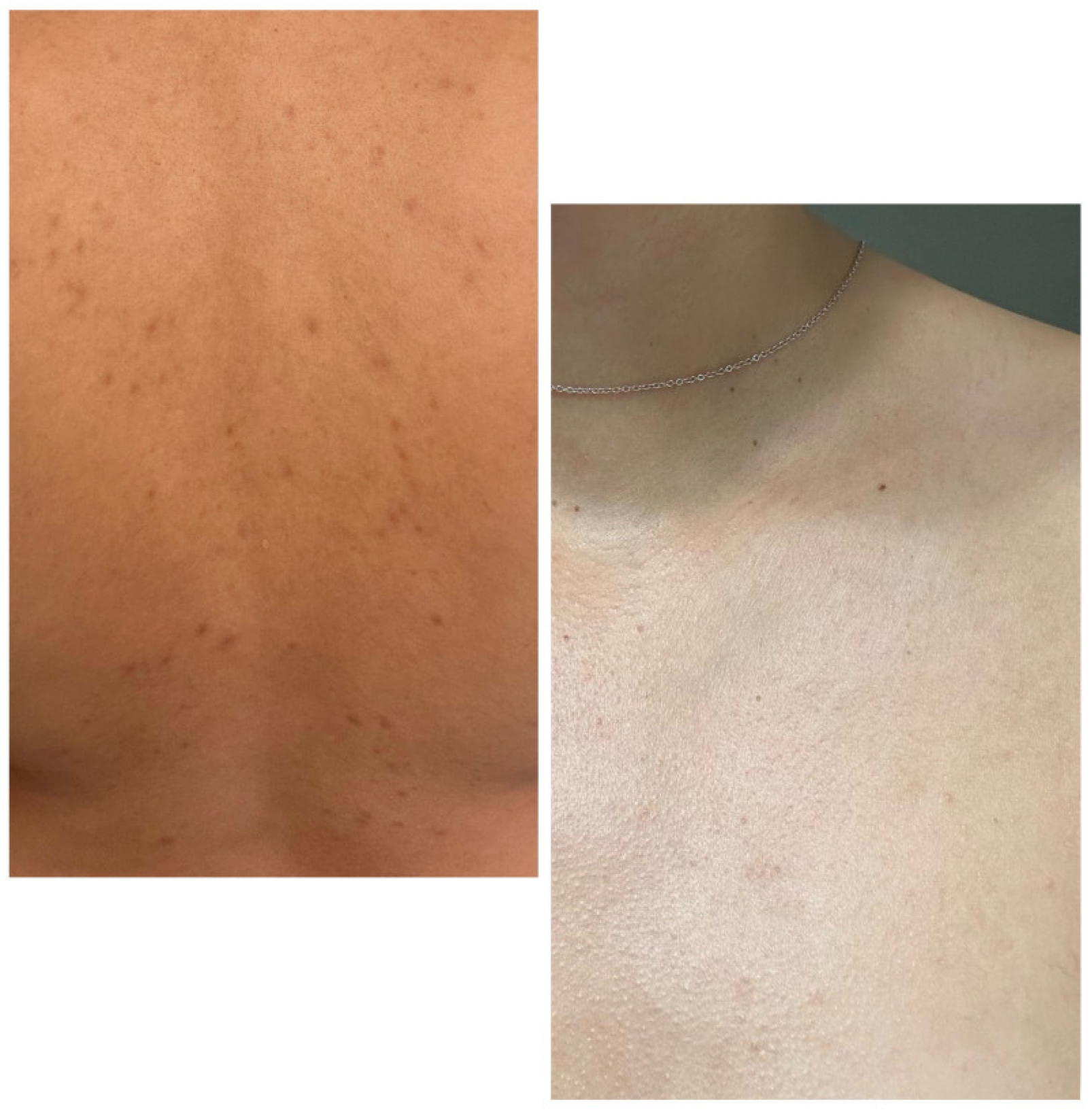Acne Vulgaris on the Upper Back and Chest Induced by Moisturizer Overuse: A Brief Review of a Case
Abstract
1. Introduction
2. Case Synopsis
3. Case Discussion
- Skin type: Fitzpatrick type IV;
- Menstrual and hormonal profile: Regular menses, with no clinical or biochemical signs of hormonal imbalance and no features suggestive of PCOS;
- Contraceptive history: Not using hormonal birth control;
- Psychosocial factors: The patient reported mild emotional impact due to the visibility of acne lesions and post-inflammatory pigmentation;
- Smoking/alcohol use: Non-smoker and infrequent alcohol consumption;
- Environmental factors: No notable occupational or environmental exposures;
- Family history: Positive for acne in first-degree relatives.
4. Conclusions
Author Contributions
Funding
Institutional Review Board Statement
Informed Consent Statement
Data Availability Statement
Conflicts of Interest
References
- Layton, A.M.; Ravenscroft, J. Adolescent acne vulgaris: Current and emerging treatments. Lancet Child Adolesc. Health 2023, 7, 136–144. [Google Scholar] [CrossRef] [PubMed]
- Youn, S.W. The role of facial sebum secretion in acne pathogenesis: Facts and controversies. Clin Dermatol. 2010, 28, 8–11. [Google Scholar] [CrossRef] [PubMed]
- Kurokawa, I.; Danby, F.W.; Ju, Q.; Wang, X.; Xiang, L.F.; Xia, L.; Chen, W.; Nagy, I.; Picardo, M.; Suh, D.H.; et al. New developments in our understanding of acne pathogenesis and treatment. Exp. Dermatol. 2009, 18, 821–832. [Google Scholar] [CrossRef] [PubMed]
- Alexis, A.F. Acne vulgaris in skin of color: Understanding nuances and optimizing treatment. Dermatol. Clin. 2014, 32, 233–242. [Google Scholar]
- Maarouf, M.; Saberian, C.; Shi, V.Y. Myths, Truths, and Clinical Relevance of Comedogenicity Product Labeling. JAMA Dermatol. 2018, 154, 1131–1132. [Google Scholar] [CrossRef] [PubMed]
- Marson, J.; Bhatia, N.; Graber, E.; Harper, J.; Lio, P.; Tlougan, B.; Nussbaum, D.; Baldwin, H. The Role of Epidermal Barrier Dysfunction and Cutaneous Microbiome Dysbiosis in the Pathogenesis and Management of Acne Vulgaris and Rosacea. J. Drugs Dermatol. 2022, 21, S5–S14. [Google Scholar]
- Schachner, L.; Alexis, A.; Andriessen, A.; Baldwin, H.; Cork, M.; Kirsner, R.; Woolery-Lloyd, H. The Importance of a Healthy Skin Barrier From the Cradle to the Grave Using Ceramide-Containing Cleansers and Moisturizers: A Review and Consensus. J. Drugs Dermatol. 2023, 22, S3–S14. [Google Scholar]
- Pappas, A. Epidermal surface lipids. Dermatoendocrinol. 2009, 1, 72–76. [Google Scholar] [CrossRef] [PubMed]
- Conforti, C.; Giuffrida, R.; Fadda, S.; Fai, A.; Romita, P.; Zalaudek, I.; Dianzani, C. Topical dermocosmetics and acne vulgaris. Dermatol Ther. 2021, 34, e14436. [Google Scholar] [CrossRef] [PubMed]
- Fabbrocini, G.; Annunziata, M.C.; D’Arco, V.; De Vita, V.; Lodi, G.; Mauriello, M.C.; Pastore, F.; Monfrecola, G. Acne scars: Pathogenesis, classification and treatment. Dermatol. Res. Pract. 2010, 2010, 893080. [Google Scholar] [CrossRef] [PubMed]
- Moradi Tuchayi, S.; Makrantonaki, E.; Ganceviciene, R.; Dessinioti, C.; Feldman, S.R.; Zouboulis, C.C. Acne vulgaris. Nat. Rev. Dis. Prim. 2015, 1, 15029. [Google Scholar] [CrossRef] [PubMed]
- Thiboutot, D.M.; Dréno, B.; Abanmi, A.; Alexis, A.F.; Araviiskaia, E.; Cabal, M.I.B.; Bettoli, V.; Casintahan, F.; Chow, S.; da Costa, A.; et al. Practical management of acne for clinicians: An international consensus from the Global Alliance to Improve Outcomes in Acne. J. Am. Acad. Dermatol. 2009, 60 (Suppl. 5), S1–S50. [Google Scholar] [CrossRef] [PubMed]
- Keri, J.; Shiman, M. An update on the management of acne vulgaris. Clin. Cosmet. Investig. Dermatol. 2009, 2, 105–110. [Google Scholar] [CrossRef] [PubMed]
- Clark, A.K.; Saric, S.; Sivamani, R.K. Acne Scars: How Do We Grade Them? Am. J. Clin. Dermatol. 2018, 19, 139–144. [Google Scholar] [CrossRef] [PubMed]
- Dursun, R.; Daye, M.; Durmaz, K. Acne and rosacea: What’s new for treatment? Dermatol. Ther. 2019, 32, e13020. [Google Scholar] [CrossRef] [PubMed]
- Goh, C.L.; Wu, Y.; Welsh, B.; Abad-Casintahan, M.F.; Tseng, C.; Sharad, J.; Jung, S.; Rojanamatin, J.; Sitohang, I.B.S.; Chan, H.N.K. Expert consensus on holistic skin care routine: Focus on acne, rosacea, atopic dermatitis, and sensitive skin syndrome. J. Cosmet. Dermatol. 2023, 22, 45–54. [Google Scholar] [CrossRef] [PubMed]
- Reynolds, R.V.; Yeung, H.; Cheng, C.E.; Cook-Bolden, F.; Desai, S.R.; Druby, K.M.; Freeman, E.E.; Keri, J.E.; Stein Gold, L.F.; Tan, J.K.L.; et al. Guidelines of care for the management of acne vulgaris. J. Am. Acad. Dermatol. 2024, 90, 1006.e1–1006.e30. [Google Scholar] [CrossRef] [PubMed]



Disclaimer/Publisher’s Note: The statements, opinions and data contained in all publications are solely those of the individual author(s) and contributor(s) and not of MDPI and/or the editor(s). MDPI and/or the editor(s) disclaim responsibility for any injury to people or property resulting from any ideas, methods, instructions or products referred to in the content. |
© 2025 by the authors. Licensee MDPI, Basel, Switzerland. This article is an open access article distributed under the terms and conditions of the Creative Commons Attribution (CC BY) license (https://creativecommons.org/licenses/by/4.0/).
Share and Cite
Azizi, F.; Sum, K.; Azizi, N.; Maibach, H.I. Acne Vulgaris on the Upper Back and Chest Induced by Moisturizer Overuse: A Brief Review of a Case. Dermato 2025, 5, 10. https://doi.org/10.3390/dermato5020010
Azizi F, Sum K, Azizi N, Maibach HI. Acne Vulgaris on the Upper Back and Chest Induced by Moisturizer Overuse: A Brief Review of a Case. Dermato. 2025; 5(2):10. https://doi.org/10.3390/dermato5020010
Chicago/Turabian StyleAzizi, Farnaz, Katie Sum, Nazanin Azizi, and Howard I. Maibach. 2025. "Acne Vulgaris on the Upper Back and Chest Induced by Moisturizer Overuse: A Brief Review of a Case" Dermato 5, no. 2: 10. https://doi.org/10.3390/dermato5020010
APA StyleAzizi, F., Sum, K., Azizi, N., & Maibach, H. I. (2025). Acne Vulgaris on the Upper Back and Chest Induced by Moisturizer Overuse: A Brief Review of a Case. Dermato, 5(2), 10. https://doi.org/10.3390/dermato5020010







